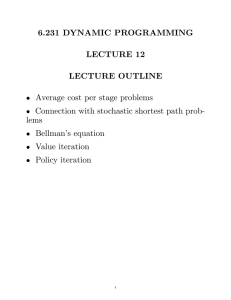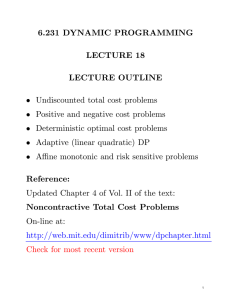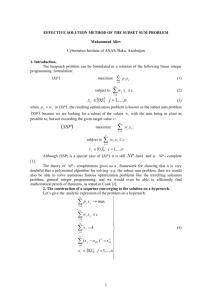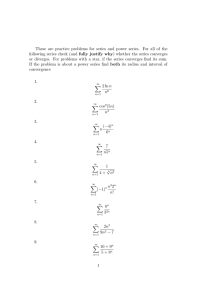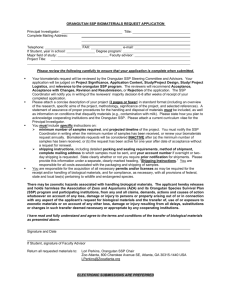6.231 DYNAMIC PROGRAMMING LECTURE 17 LECTURE OUTLINE • Undiscounted problems
advertisement
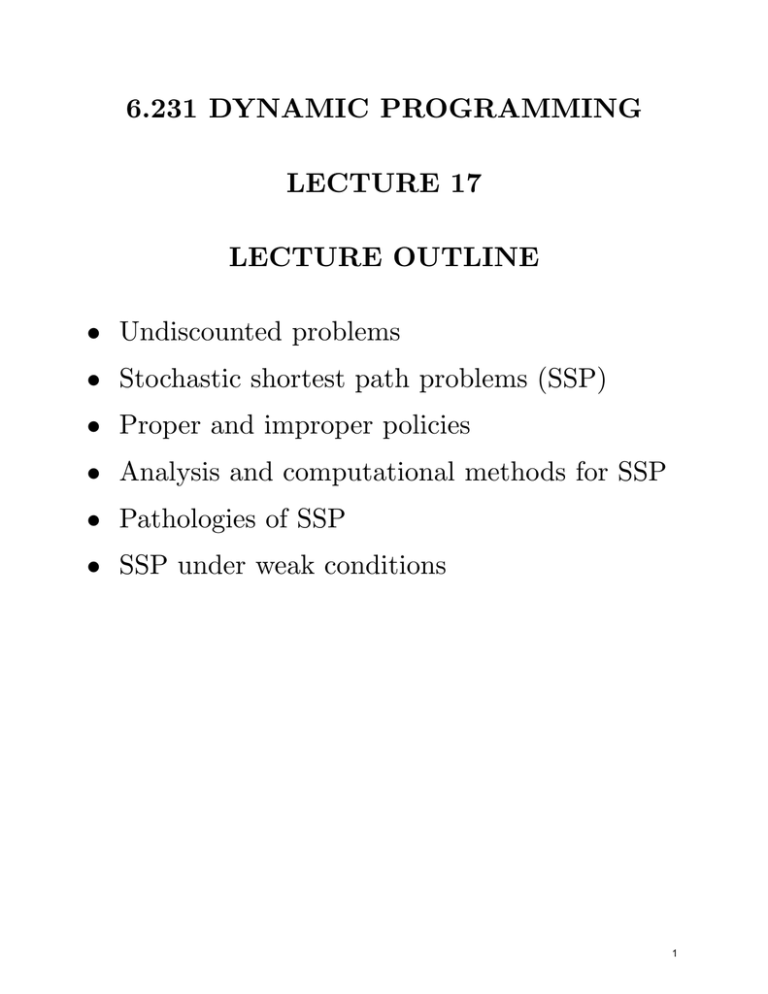
6.231 DYNAMIC PROGRAMMING
LECTURE 17
LECTURE OUTLINE
• Undiscounted problems
• Stochastic shortest path problems (SSP)
• Proper and improper policies
• Analysis and computational methods for SSP
• Pathologies of SSP
• SSP under weak conditions
1
UNDISCOUNTED PROBLEMS
• System: xk+1 = f (xk , uk , wk )
• Cost of a policy π = {µ0 , µ1 , . . .}
Jπ (x0 ) = lim sup
N →∞
E
wk
k=0,1,...
(N −1
X
g xk , µk (xk ), wk
k=0
)
Note that Jπ (x0 ) and J ∗ (x0 ) can be +∞ or −∞
• Shorthand notation for DP mappings
(T J)(x) = min E g(x, u, w) + J f (x, u, w)
u∈U (x) w
(Tµ J)(x) = E g x, µ(x), w + J f (x, µ(x), w)
w
, ∀x
, ∀x
• T and Tµ need not be contractions in general,
but their monotonicity is helpful (see Ch. 4, Vol.
II of text for an analysis).
• SSP problems provide a “soft boundary” between the easy finite-state discounted problems
and the hard undiscounted problems.
− They share features of both.
− Some nice theory is recovered thanks to the
termination state, and special conditions.
2
SSP THEORY SUMMARY I
• As before, we have a cost-free term. state t, a
finite number of states 1, . . . , n, and finite number
of controls.
• Mappings T and Tµ (modified to account for
termination state t). For all i = 1, . . . , n:
n
X
(Tµ J)(i) = g i, µ(i) +
pij µ(i) J(j),
j=1
(T J)(i) = min g(i, u) +
u∈U (i)
n
X
j=1
pij (u)J(j) ,
or Tµ J = gµ + Pµ J and T J = minµ [gµ + Pµ J].
• Definition: A stationary policy µ is called proper,
if under µ, from every state i, there is a positive
probability path that leads to t.
• Important fact: (To be shown) If µ is proper,
Tµ is contraction w. r. t. some weighted sup-norm
1
1
′
max |(Tµ J)(i)−(Tµ J )(i)| ≤ ρµ max |J(i)−J ′ (i)|
i
i
vi
vi
• T is similarly a contraction if all µ are proper
(the case discussed in the text, Ch. 7, Vol. I).
3
SSP THEORY SUMMARY II
• The theory can be pushed one step further.
Instead of all policies being proper, assume that:
(a) There exists at least one proper policy
(b) For each improper µ, Jµ (i) = ∞ for some i
• Example: Deterministic shortest path problem
with a single destination t.
− States <=> nodes; Controls <=> arcs
− Termination state <=> the destination
− Assumption (a) <=> every node is connected to the destination
− Assumption (b) <=> all cycle costs > 0
• Note that T is not necessarily a contraction.
• The theory in summary is as follows:
− J ∗ is the unique solution of Bellman’s Eq.
− µ∗ is optimal if and only if Tµ∗ J ∗ = T J ∗
− VI converges: T k J → J ∗ for all J ∈ ℜn
− PI terminates with an optimal policy, if started
with a proper policy
4
SSP ANALYSIS I
• For a proper policy µ, Jµ is the unique fixed
point of Tµ , and Tµk J → Jµ for all J (holds by the
theory of Vol. I, Section 7.2)
• Key Fact: A µ satisfying J ≥ Tµ J for some
J ∈ ℜn must be proper - true because
J ≥ Tµk J = Pµk J +
P∞
k−1
X
Pµm gµ
m=0
since Jµ = m=0 Pµm gµ and some component of
the term on the right blows up as k → ∞ if µ is
improper (by our assumptions).
• Consequence: T can have at most one fixed
point within ℜn .
Proof: If J and J ′ are two fixed points, select µ
and µ′ such that J = T J = Tµ J and J ′ = T J ′ =
Tµ′ J ′ . By preceding assertion, µ and µ′ must be
proper, and J = Jµ and J ′ = Jµ′ . Also
J = T k J ≤ Tµk′ J → Jµ′ = J ′
Similarly, J ′ ≤ J, so J = J ′ .
5
SSP ANALYSIS II
• We first show that T has a fixed point, and also
that PI converges to it.
• Use PI. Generate a sequence of proper policies
{µk } starting from a proper policy µ0 .
• µ1 is proper and Jµ0 ≥ Jµ1 since
Jµ0 = Tµ0 Jµ0 ≥ T Jµ0 = Tµ1 Jµ0 ≥ Tµk1 Jµ0 ≥ Jµ1
• Thus {Jµk } is nonincreasing, some policy µ̄ is
repeated and Jµ̄ = T Jµ̄ . So Jµ̄ is fixed point of T .
• Next show that T k J → Jµ̄ for all J, i.e., VI
converges to the same limit as PI. (Sketch: True
if J = Jµ̄ , argue using the properness of µ̄ to show
that the terminal cost difference J − Jµ̄ does not
matter.)
• To show Jµ̄ = J ∗ , for any π = {µ0 , µ1 , . . .}
Tµ0 · · · Tµk−1 J0 ≥ T k J0 ,
where J0 ≡ 0. Take lim sup as k → ∞, to obtain
Jπ ≥ Jµ̄ , so µ̄ is optimal and Jµ̄ = J ∗ .
6
SSP ANALYSIS III
• Contraction Property: If all policies are proper
(cf. Section 7.1, Vol. I), Tµ and T are contractions
with respect to a weighted sup norm.
Proof: Consider a new SSP problem where the
transition probabilities are the same as in the original, but the transition costs are all equal to −1.
Let Jˆ be the corresponding optimal cost vector.
For all µ,
Ĵ(i) = −1+ min
u∈U (i)
n
X
n
X
pij (u)Ĵ(j) ≤ −1+
j=1
pij µ(i) Ĵ(j )
j=1
ˆ
For vi = −J(i),
we have vi ≥ 1, and for all µ,
n
X
j=1
pij µ(i) vj ≤ vi − 1 ≤ ρ vi ,
where
i = 1, . . . , n,
vi − 1
< 1.
i=1,...,n
vi
ρ = max
This implies Tµ and T are contractions of modulus ρ for norm kJk = maxi=1,...,n |J(i)|/vi (by the
results of earlier lectures).
7
SSP ALGORITHMS
• All the basic algorithms have counterparts under our assumptions; see the text (Ch. 3, Vol. II)
• “Easy” case: All policies proper, in which case
the mappings T and Tµ are contractions
• Even with improper (infinite cost) policies all
basic algorithms have satisfactory counterparts
− VI and PI
− Optimistic PI
− Asynchronous VI
− Asynchronous PI
− Q-learning analogs
• ** THE BOUNDARY OF NICE THEORY **
• Serious complications arise under any one of the
following:
− There is no proper policy
− There is improper policy with finite cost ∀ i
− The state space is infinite and/or the control
space is infinite [infinite but compact U (i)
can be dealt with]
8
PATHOLOGIES I: DETERM. SHORTEST PATHS
t b c u′ , Cost 0
t b Destination
u, Cost b
a12
12tb
• Two policies, one proper (apply u), one improper (apply u′ )
• Bellman’s equation is
J(1) = min J(1), b]
Set of solutions is (−∞, b].
• Case b > 0, J ∗ = 0: VI does not converge to
J ∗ except if started from J ∗ . PI may get stuck
starting from the inferior proper policy
• Case b < 0, J ∗ = b: VI converges to J ∗ if
started above J ∗ , but not if started below J ∗ . PI
can oscillate (if started with u′ it generates u, and
if started with u it can generate u′ )
9
PATHOLOGIES II: BLACKMAILER’S DILEMMA
• Two states, state 1 and the termination state t.
• At state 1, choose u ∈ (0, 1] (the blackmail
amount demanded) at a cost −u, and move to t
with prob. u2 , or stay in 1 with prob. 1 − u2 .
• Every stationary policy is proper, but the control set in not finite (also not compact).
• For any stationary µ with µ(1) = u, we have
Jµ (1) = −u + (1 − u2 )Jµ (1)
from which Jµ (1) = − u1
• Thus J ∗ (1) = −∞, and there is no optimal
stationary policy.
• A nonstationary policy is optimal: demand
µk (1) = γ/(k + 1) at time k, with γ ∈ (0, 1/2).
− Blackmailer requests diminishing amounts over
time, which add to ∞.
− The probability of the victim’s refusal diminishes at a much faster rate, so the probability that the victim stays forever compliant is
strictly positive.
10
SSP UNDER WEAK CONDITIONS I
• Assume there exists a proper policy, and J ∗ is
real-valued. Let
ˆ =
J(i)
min Jµ (i),
µ: proper
i = 1, . . . , n
ˆ 6= J ∗ (i)
Note that we may have Jˆ 6= J ∗ [i.e., J(i)
for some i].
• It can be shown that Jˆ is the unique solution
ˆ
of Bellman’s equation within the set {J | J ≥ J}
• Also VI converges to Jˆ starting from any J ≥ Jˆ
• The analysis is based on the δ-perturbed problem: adding a small δ > 0 to g. Then:
− All improper policies have infinite cost for
some states in the δ-perturbed problem
− All proper policies have an additional O(δ)
cost for all states
− The optimal cost Jδ∗ of the δ-perturbed problem converges to Jˆ as δ ↓ 0
• There is also a PI method that generates a
ˆ Uses sequence δk ↓
sequence {µk } with Jµk → J.
0, and policy evaluation based on the δk -perturbed
problems with δk ↓ 0.
11
SSP UNDER WEAK CONDITIONS II
• J ∗ need not be a solution of Bellman’s equation!
Also Jµ for an improper policy µ.
u Cost 0 Cost
012345
Prob. p
012345
Cost 0 Cost 2 Cost −2 Cost
p Prob. 1 − p
0 1 2 3 4 50 1 2 3 4 5
1 Cost 1
01234567
u Cost −1 Cost 1 Cost 0 Cost 2 Cost
t b Destination
01234567
012345
12tb
u Cost −1 Cost 1
1 Cost 1
) Cost 0
• For p = 1/2, we have
Jµ (1) = 0, Jµ (2) = Jµ (5) = 1, Jµ (3) = Jµ (7) = 0, Jµ (4) = Jµ (6) = 2,
Bellman Eq. at state 1, Jµ (1) =
is violated.
1
2
Jµ (2)+Jµ (5) ,
• References: Bertsekas, D. P., and Yu, H., 2015.
“Stochastic Shortest Path Problems Under Weak
Conditions,” Report LIDS-2909; Math. of OR, to
appear. Also the on-line updated Ch. 4 of the
text.
12
MIT OpenCourseWare
http://ocw.mit.edu
6.231 Dynamic Programming and Stochastic Control
Fall 2015
For information about citing these materials or our Terms of Use, visit: http://ocw.mit.edu/terms.


